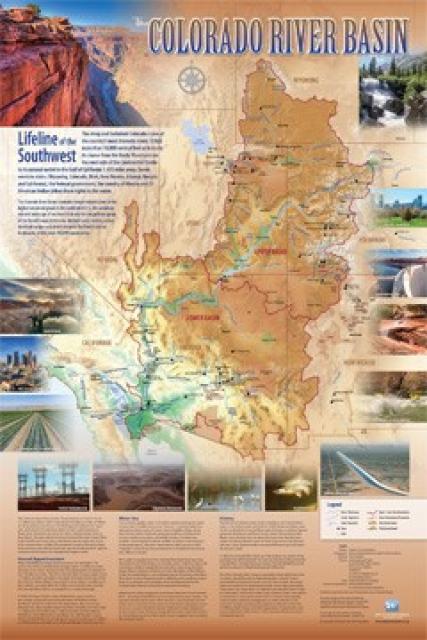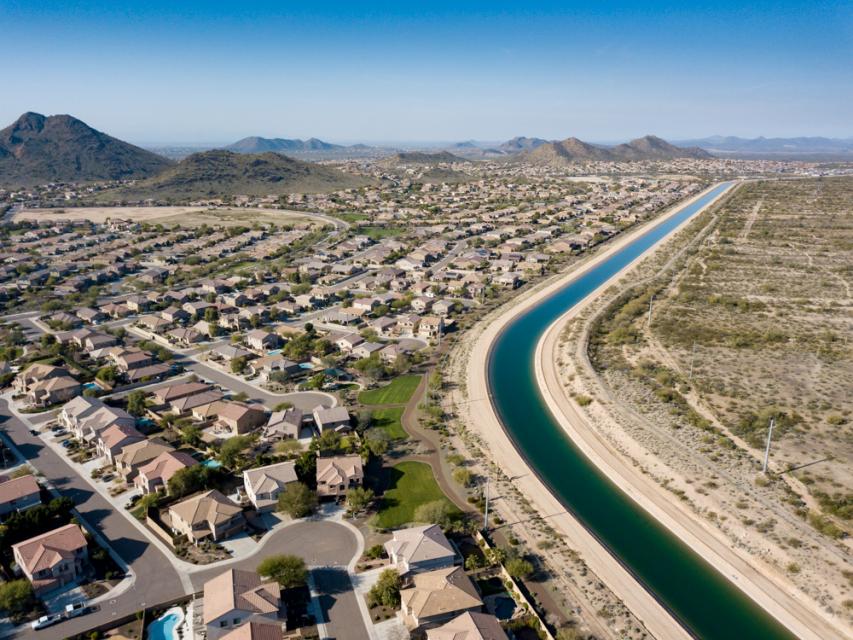A Water Deal Between Equals
WESTERN WATER SPOTLIGHT: New Mexico’s Pact with Jicarilla Apache Nation Shows ‘How We Can Do More with Less’
 Nobody had leverage and everybody
had something to gain.
Nobody had leverage and everybody
had something to gain.
Negotiators for the Jicarilla Apache Nation, the state of New Mexico and The Nature Conservancy worked together remotely for two years during the COVID-19 pandemic on an unprecedented pact that would keep 200,000 acre-feet of water in the Colorado River.
They didn’t meet in person until the winter of 2022 at the Jicarilla Apache Nation’s 36,000-acre Lodge and Ranch at Chama, a northern New Mexico reserve for hunting elk, bear and mule deer. Taking COVID safety precautions, they worked outside the fireplace-warmed lodge.
Celene Hawkins, who heads the conservancy’s tribal engagement in the Colorado River Basin, said the negotiators were so engrossed in the fine details as they talked outside that they ignored a boisterous flock of wild turkeys approaching them from behind.
“I don’t know if they are wild or tame,” she recalled thinking. “At what point do I interrupt this conversation to make sure everybody’s safe from the turkeys?”
“Essentially, all the stars aligned.”
~Ali Effati, New Mexico’s negotiator
In the end, everybody got what they wanted. The state agreed to a 10-year lease with the tribe, reserving up to 20,000 acre-feet of the tribe’s water each year. The conservancy lined up private funding to maximize the amount of water leased to support two imperiled native fish species, the razorback sucker and the Colorado pikeminnow.
New Mexico had prepared for this opportunity years ago. The state Legislature created a strategic water reserve in 2005, empowering the state’s Interstate Stream Commission to acquire water for contingencies and to aid endangered fish. Ali Effati, the agency’s Colorado River Basin Bureau Chief, said the water in the reserve stays in the San Juan River past the state line all the way down to Lake Powell.
The Jicarilla Apache Nation, meanwhile, found itself needing a new customer for the water it had been leasing to the Public Service Company of New Mexico. In 2019, the utility started decommissioning its coal-fired San Juan Generating Station, freeing up the tribe’s water for another deal.
“Essentially, all the stars aligned,” Effati said.
Paying to Leave Water in River
Both sides had to perform due diligence on issues like dispute resolution, insurance requirements and employment law, said Jenny Dumas, a water rights attorney for the tribe. The most interesting part, she said, was that the tribe and the state of New Mexico had never worked together as equal sovereign governments.
 “The states give money to tribes
all the time and those are what we call adhesion contracts,”
Dumas said. “It’s like, ‘Here’s the contract you signed to get
the money. These are the rules you comply with.’ We were not able
to find a single transaction that we could analogize and say,
‘Here’s an instance where the state and a tribe entered into a
transaction as partners towards a common goal.’”
“The states give money to tribes
all the time and those are what we call adhesion contracts,”
Dumas said. “It’s like, ‘Here’s the contract you signed to get
the money. These are the rules you comply with.’ We were not able
to find a single transaction that we could analogize and say,
‘Here’s an instance where the state and a tribe entered into a
transaction as partners towards a common goal.’”
The thorniest discussions were over the price of water.
Under New Mexico law, the state can only pay fair market value, determined by appraising similar transactions. But it was hard to affix a proper value because there had been too few tribal water leases, Dumas said.
“Getting paid to leave water in the river is different from some of these past transactions where people were actually diverting water” for a drinking supply or growing crops, she said. “There’s not a lot of good data for what the water should be worth. I think the number we had to settle on was too low.”
In 2023, the first year of the water lease, New Mexico ordered the full 20,000-acre feet at $88 per acre-foot. The price will be adjusted for inflation every two years.
The state’s process of disbursing funds further complicated the deal.
The state Legislature must approve the money each year of the deal and, because of the vagaries of the legislative calendar, the state’s Interstate Stream Commission could not guarantee it would be able to pay for the full lease over 10 years.
That’s where private money from the conservancy came in handy.
 The conservancy is bridging those
gaps with donor funds, ensuring the maximum amount of water –
20,000 acre-feet – could be leased to the state each year.
The conservancy is bridging those
gaps with donor funds, ensuring the maximum amount of water –
20,000 acre-feet – could be leased to the state each year.
Throughout the negotiations, Hawkins was struck by the absence of posturing and tension between the parties.
“It didn’t feel like there were two governments and a conservation group that were only working in the shared interest space,” she recalled. “We were trying something new. We were doing something big together, and so the differences didn’t actually come up as much as you would think. A lot of it was really trying to figure out what might be possible together.”
Hawkins believes deals like this one that satisfies multiple water needs are the wave of the future as the Colorado River system dwindles in a hotter, drier climate.
“Especially for The Nature Conservancy, we know that there’s not going to be extra water in the Basin going forward to just meet environmental purposes,” Hawkins said.
“This is a really important example,” she added, “of how we can do more with less and make sure that we’re taking care of the rivers when we’re also taking care of water supply issues.”
Reach Editor Vik Jolly at vjolly@watereducation.org
Know someone who wants to stay connected to water in the West? Encourage them to sign up for Western Water and follow us on Twitter, LinkedIn, Facebook and Instagram.











